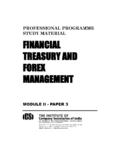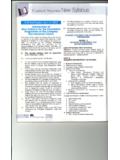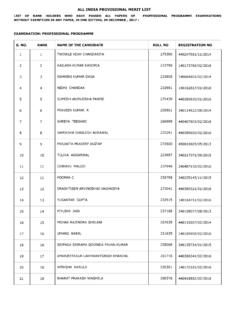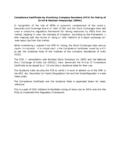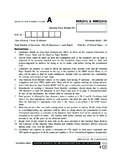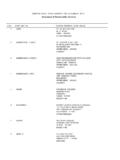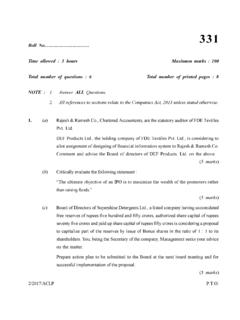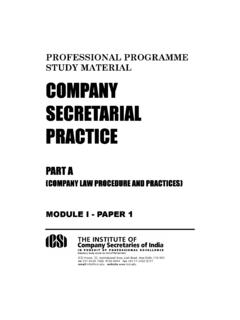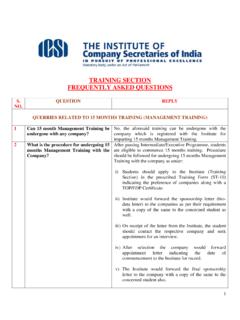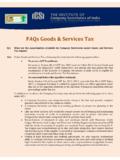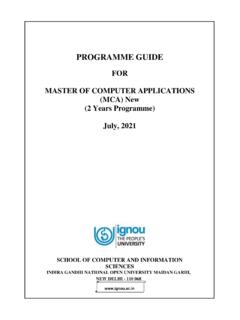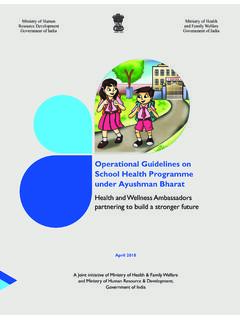Transcription of EXECUTIVE PROGRAMME New Syllabus - ICSI
1 GUIDELINE ANSWERSEXECUTIVE PROGRAMME (New Syllabus )DECEMBER 2019 MODULE 1 ICSI House, 22, Institutional Area, Lodi Road, New Delhi 110 003 Phones : 41504444, 45341000; Fax : 011-24626727E-mail : Website : answers have been written by competent personsand the Institute hope that the GUIDELINE ANSWERS willassist the students in prepar ing for th e Institute'sexaminations. It is, however, to be noted that the answersare to be treated as model answers and not as exhaustiveand the Institute is not in any way responsible for thecorrectness or otherwise of the answers compiled andpublished O N T E N T S PageMODULE , Interpretation & General up of Business Entities and Guideline Answers contain the information based on theLaws/Rules applicable at the time of preparation.
2 However,students are expected to be well versed with the amendmentsin the Laws/Rules made upto six months prior to the date JI&GL December 2019 JURISPRUDENCE, INTERPRETATION & GENERAL LAWSTime allowed : 3 hours Maximum marks : 100 NOTE :Answer ALL 1(a)Discuss the Doctrine of Stare Decisis , under the sources of law.(b)Rajasthan Legislature passed a law restricting the use of sound amplifiers. Thelaw was challenged on the ground that it deals with a matter which falls in entry81 of List-I under the Constitution of India which reads : Post and telegraphs, telephones, wireless broadcasting and other like forms ofcommunication and therefore, the State Legislature was not competent to passit. Examine the proposition in the light of Pith and Substance Rule referringthe case law on this point.
3 (c)Describe Arbitration Agreement specified under Section 7 of the Arbitrationand Conciliation Act, 1996.(d)Describe the Rule of Reasonable Construction under the Interpretation ofStatutes. (5 marks each)Answer 1(a)The doctrine of stare decisis means adherence to the past decision and do notunsettle things which are established. It is a useful doctrine intended to bring aboutcertainty and uniformity in the law. Under the stare decisis doctrine, a principle of lawwhich has become settled by a series of decisions generally is binding on the courts andshould be followed in similar cases. In simple words, the principle means that like casesshould be decided alike. This doctrine is based on public policy. Although doctrineshould be strictly adhered to by the Courts, it is not universally applicable.
4 The doctrineshould not be regarded as a rigid and inevitable doctrine which must be applied at thecost of 1(b)The Rule of Pith and Substance means that where a law in reality and substancefalls within an item on which the legislature which enacted that law is competent tolegislate, then such law shall not become invalid merely because it incidentally touchesa matter outside the competence of on Entry 6 of List II of the Constitution of India which reads Public Healthand Sanitation, Rajasthan Legislature passed a law restricting the use of soundamplifiers. The law was challenged on the Schedule VII, entry 31 of List I of theConstitution of India deals with "Post and telegraphs, telephones, wireless broadcastingand other like forms of communication, and, therefore, the State Legislature was notEXECUTIVE PROGRAMME EXAMINATIONDECEMBER 2019EP JI&GL December 20192competent to pass it.
5 The Supreme Court rejected this argument on the ground that theobject of the law was to prohibit unnecessary noise affecting the health of public and notto make a law on broadcasting, etc. Therefore, the pith and substance of the law was public health and not broadcasting (G. Chawla v. State of Rajasthan, AIR 1959 SC544).Answer 1(c)According to Section 2(1) (b) of the Arbitration and Conciliation Act, 1996, arbitrationagreement means an agreement referred to in Section 7 of the Act. Under Section 7, theArbitration agreement has been defined to mean an agreement by the parties to submitto arbitration all or certain disputes which have arisen or which may arise between themin respect of a defined legal relationship, whether contractual or not. An arbitration agreement may be in the form of an arbitration clause in a contractor in the form of a separate agreement.
6 An arbitration agreement shall be in writing. An arbitration agreement is in writing if it is contained in- a document signed by the parties; an exchange of letters, telex, telegrams or other means of telecommunicationincluding communication through electronic means which provide a recordof the agreement; or an exchange of statements of claim and defence in which the existence ofthe agreement is alleged by one party and not denied by the other. The reference in a contract to a document containing an arbitration clauseconstitutes an arbitration agreement if the contract is in writing and the referenceis such as to make that arbitration clause part of the 1(d)According to Rule of Reasonable Construction the words of a statute must beconstrued ut res magis valeat quam pereat, so as to give a sensible meaning to provision of law cannot be so interpreted as to divorce it entirely from common sense;every word or expression used in an Act should receive a natural and fair is the duty of a Court in constructing a statute to give effect to the intention of thelegislature.
7 If, therefore, giving of literal meaning to a word used by the draftsmanparticularly in penal statute would defeat the object of the legislature, which is to suppressa mischief, the Court can depart from the dictionary meaning which will advance theremedy and suppress the is only when the language of a statute, in its ordinary meaning and grammaticalconstruction, leads to a manifest contradiction of the apparent purpose of the enactment,or to some inconvenience or absurdity, hardship or injustice, presumably not intended,a construction may be put upon it which modifies the meaning of the words and even thestructure of the sentence (Tirath Singh v. Bachittar Singh, 1955 830).Courts can depart from dictionary meaning of a word and give it a meaning which will3EP JI&GL December 2019advance the remedy and suppress the mischief provided the Court does not haveto conjecture or surmise.
8 A construction will be adopted in accordance with the policyand object of the statute (Kanwar Singh v. Delhi Administration, AIR 1965 871).Attempt all parts of either Q. No. 2 or Q. No. 2 AQuestion 2(a)Explain the role of Preamble as internal aid in interpretation of statute. Thoughthe preamble cannot be used to defect the enacting clause of a statute, it hasbeen treated to be a key for the interpretation of the statute. Examine.(b)Enumerate any four categories of cases in which a police officer may arrest aperson without an order from magistrate and without a warrant under section 41of , 1973.(c)Allegation against the accused was that he furnished a certificate to getemployment as ETT Teacher which was found to be bogus and forged in asmuch as school was not recognized for period given in the certificate.
9 However,the certificate did not anywhere say that school was recognized. Whether theaccused is guilty of any offence ? Explain with the help of decided judicialprecedent.(d)Explain the rights of a party to appear before the National Company Law Tribunal.(4 marks each)OR (Alternate question to Q. No. 2)Question 2A(i)Briefly explain the Purposive Rule of Interpretation under the General ClausesAct, 1987. (4 marks)(ii)Enumerate in short the exceptional circumstances of the application of naturaljustice under Administrative Law. (4 marks)(iii)Discuss the provisions relating to persons under legal disability under theLimitation Act, 1963. (4 marks)(iv)Describe kinds of offences under which capital punishment may be awarded byCourt under Indian Penal Code.
10 (4 marks)Answer 2(a)The true place of a preamble in a statute was at one time, the subject of conflictingdecisions. In Mills v. Wilkins, (1794) 6 Mad. 62, Lord Hold said: the preamble of astatute is not part thereof, but contains generally the motives or inducement thereof . Onthe other hand, it was said that the preamble is to be considered, for it is the key to openthe meaning of the makers of the Act, and the mischief it was intended to remedy .The modern rule lies between these two extremes and is that where the enactingpart is explicit and unambiguous the preamble cannot be resorted to, control, qualify orrestrict it, but where the enacting part is ambiguous, the preamble can be referred toexplain and elucidate it [Raj Mal v. Harnam Singh, (1928) 9 Lah.]
